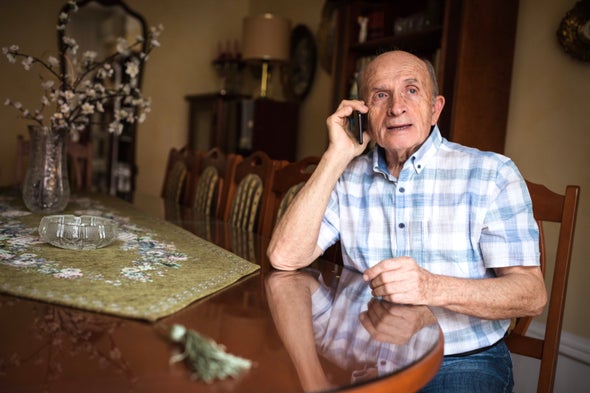Loneliness is not just a feeling; it is also a public health problem that has been linked to increased risk of mental health issues, heart disease and even death. With rates of loneliness on the rise in the U. S. and around the world, people are addressing this crisis using everything from companion robots to social networking sites and apps. A new study in JAMA Psychiatry suggests that a better solution may lie in a much older, more ubiquitous form of technology: phone calls.
Even before the COVID-19 pandemic forced people into isolation, separating them from friends, co-workers and loved ones, experts were beginning to consider loneliness an epidemic—one affecting an estimated three out of five Americans. A study from the National Academies of Sciences, Engineering, and Medicine (NASEM), published last year, recognizes the health risks social isolation and loneliness present—and the limited interventions available to address them.
“There is a lot of variability in terms of the types of interventions, the level of evidence to support them and the rigor of evidence,” says Julianne Holt-Lunstad, a professor of psychology and neuroscience at Brigham Young University, who was a member of the NASEM committee that published the report. Some potential solutions, such as grassroots-based pen-pal programs for socially isolated adults, sound promising based on anecdotal evidence, but researchers have not adequately studied them. Other experiments are still ongoing: Holt-Lunstad, in collaboration with the social-networking service Nextdoor and researchers in the U.K. and Australia, conducted a study (currently being prepared for publication) that suggests that performing small acts of kindness for neighbors reduced the likelihood of feeling lonely and socially isolated.
ADVERTISEMENT
Now a new paper published in JAMA Psychiatry shows that a program of phone calls focused on empathetic conversation can help. Over the course of four weeks, the experiment saw an overall reduction in symptoms of loneliness, depression and anxiety in at-risk adults aged 27 to 101. “It makes sense,” says Linda Fried, dean of the Mailman School of Public Health at Columbia University, who was not involved in the study. “In an emergency time like the pandemic, phone calls can make a big difference in allaying feelings of fright and anxiety.”
“A lot of care went into designing the protocol so that it was all about the person at the other end,” says Maninder Kahlon, lead author of the study and executive director of Factor Health, an organization for developing health care programs at the University of Texas at Austin. For example, the experiment customized each person’s program depending on how frequently they wanted to receive calls—from two to five times per week—and the best time of day for them to talk.
The researchers also considered how to make the phone conversations more empathetic. Steven Tomlinson, co-author of the study and an associate professor of leadership and administration at Seminary of the Southwest in Austin, Tex., drew on his experiences reviewing successful sales calls to identify which variables could be applied to the intervention to help callers connect with other people. These characteristics included asking open questions, making one point at a time to allow the call receiver to talk and following up on “clues” in the conversation to demonstrate understanding. Instead of writing a script, the researchers trained 16 callers, aged 17 to 23, in these techniques and instructed them to discuss any topic the call receiver wanted to talk about, such as an ongoing home-improvement project. “It’s not just calling up on people to check in,” Kahlon says. “It’s the deliberate thinking about how you build trust.”
Although it remains unclear if the effects last beyond the four-week study period, the researchers hope the study serves as a model for an ongoing program. If health care systems and public health agencies start building a workforce of empathetic callers, it could do more than alleviate loneliness, Kahlon suggests. Similar programs might help people with mild to moderate symptoms of depression and anxiety and complement patients’ management of chronic diseases such as diabetes and heart disease.
A phone-based intervention involving layperson callers would be accessible and scalable, but it would still require callers to undergo training and take on a lot of work. “It’s important that [the intervention] is simple and intuitive,” Kahlon says, but “simple does not mean easy.” Holt-Lunstad, who was not involved in the new study, also points out that loneliness has different sources and thus may need varying solutions. “One approach may not be appropriate for all, particularly if it’s not sensitive to the underlying causes,” Holt-Lunstad says. “Getting a phone call may work for one person, but participating in a group activity may be better for others.”
COVID has emphasized the need to address growing feelings of loneliness and isolation. For instance, Japan recently appointed a minister of loneliness in the wake of increasing rates of suicide in the country; the U.K. created a similar official position in 2018. “It may take some time to understand the long-term effects of the pandemic [on loneliness and social isolation],” Holt-Lunstad says. “One of the key takeaways from this past year is there is greater awareness of how important social connection is for our well-being.”




























